
You may have seen the traditional tan (with a black saddle) German shepherd dog, but have you ever seen the rare blue German shepherd?
These dogs are simply colored differently than other German shepherds, but they are the same breed as German shepherds.
German shepherd dogs are beloved by all who meet them, loving in nature and giving themselves completely to their owner.
This article provides a comprehensive guide covering everything you need to know about the blue German shepherd.
| Size | 24-26 inches (male) and 22-24 inches (female) |
| Weight | 65-90lb (male) and 50-75lb (female) |
| Lifespan | 9–13 years |
| Breed Type | Herding |
| Purpose | Working / Companion |
| Suitable For | Experienced Dog Owners (Including Families) |
| Color Variations | Blue |
| Temperament | Confident, Brave, Intelligent, Loyal, Self-Assured |
| Other Names | Deutscher Schäferhund, GSD |
TABLE OF CONTENTS
What is a Blue German Shepherd? Dog Breed Information
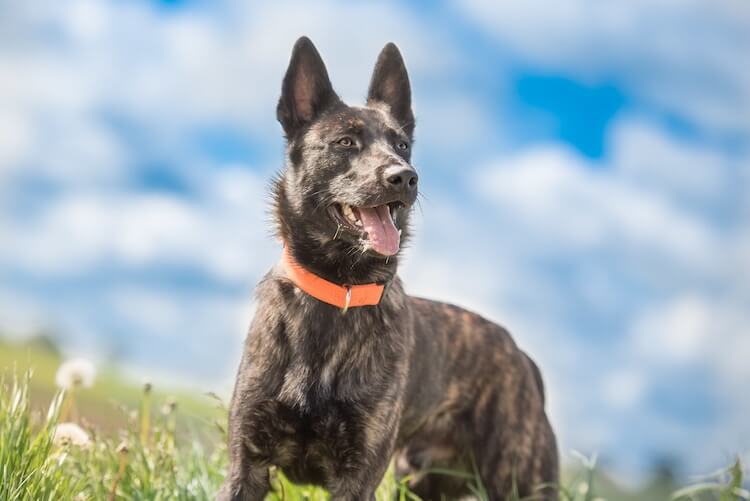
The German shepherd was first seen in America in the early 1900s, and were an immediate hit, due to their trainability and loyal nature.
Their popularity took a dip during the 1940s and 50s due to anti-German sentiment. In an attempt to combat this, their name was briefly changed to American Alsatian. Despite this, the German shepherd dog is now wildly popular with families and is the second most popular dog in America.
In the original German shepherd stud book, there are noted to be four wolf crosses in their bloodline.
Despite the fact that the German shepherd dog was originally bred as a herding dog, with the decline of traditional livestock management, they are now popular in many other roles, including:
- Disability Assistance Dog
- Search and Rescue Dog
- Police and Military Roles
- Acting
- Being a loving and loyal family pet
Although originally black and tan, the German shepherd dog now comes in many variations, including sable, gray, white and of course, blue.
It is unknown when the blue German shepherd first appeared, but it is still a rare color variation of the breed.
Dog Origin
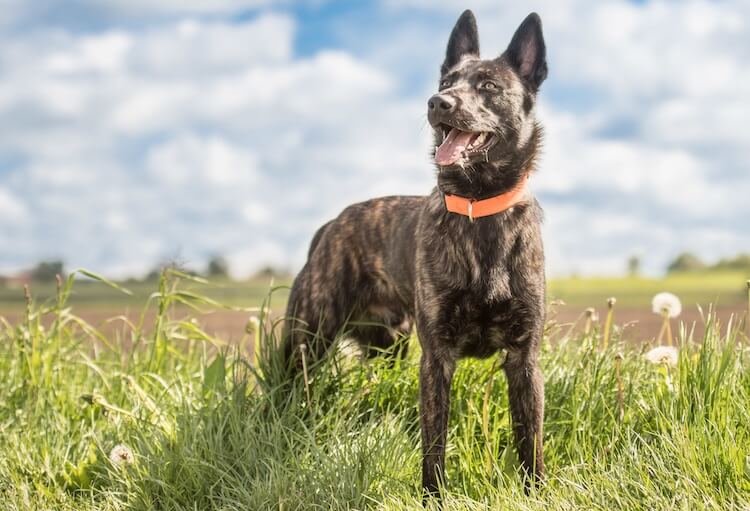
First bred in Germany in the late 1800s, the German Shepherd Dog has a relatively short history.
DNA evidence suggests that the original dogs used by the breeder (Max von Stephanitz) were most likely herding dogs of French and Italian origin.
von Stephanitz believed that dogs should be working, but he could not find any breed that satisfied his needs.
Consequently, he purchased a dog named Hektor Linksrhein who embodied what von Stephanitz was looking for.
This dog, renamed to Honrard von Grafrath, became the first ever German Shepherd Dog. As a result of this, all modern GSDs are from his line (regardless of their color).
Blue German Shepherd Puppies
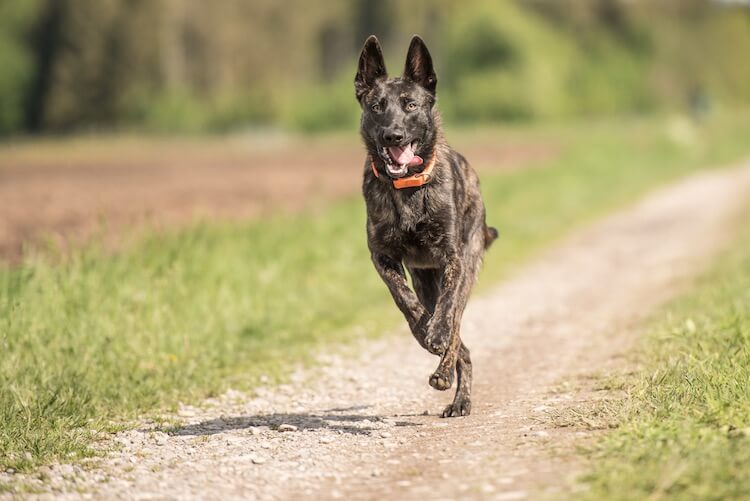
A Blue German Shepherd Puppy will cost between $1,200 – $1,500 USD. These dogs are rarer than their tan and black saddle siblings (i.e. the traditional GSD appearance).
Not a lot of breeders breed for this unique color, choosing instead to sell the much more popular tan color variation which can make finding a good breeder harder.
German Shepherds are larger dogs, and can have larger litter sizes with an average of eight puppies in a litter; but this could be anywhere from between 1 and 15 puppies.
Adult German shepherds, who are proven show dogs, may sell for between $7,000 and $9,000 USD.
The AKC has a list of AKC accredited breeders that makes it easier to find a reliable breeder in your area. If you would prefer to adopt, the German Shepherd Club of America has a list of available rescues and rescue centers all over the country.
Blue German Shepherd Temperament
Blue German shepherd dogs are incredibly loyal dogs, loving nothing more than to please their owners.These dogs have very appealing personalities, and are quickly become the favorites of anyone who encounters them. They are the perfect student, perfectly adaptable and good at pretty much everything.
However, their owner pleasing quality can make them incredibly anxious, or destructive, when left on their own for long periods of time.
Their anxious or destructive behavior can be treated with good training and socialization.

It is important to note that blue Shepherds can be very possessive with their owners and may be somewhat aloof with strangers.
This comes from their herding days, where they would be the guardian of their flock, and with no flock this trait may be transferred to humans, especially smaller children.
Whilst an undesirable quality, it can be managed, with lots of socialization from a young age. Encourage your pup to play gently with other people, giving them lots of positive reinforcement.
With a known and stable temperament, Blue German Shepherds are a popular choice for people from all walks of life.
They are a great choice for families as these dogs get on well with children and other pets.
This dog breed is also suitable for singles and couples provided you can keep up with their high exercise requirements.
Caring For A German Shepherd Dog
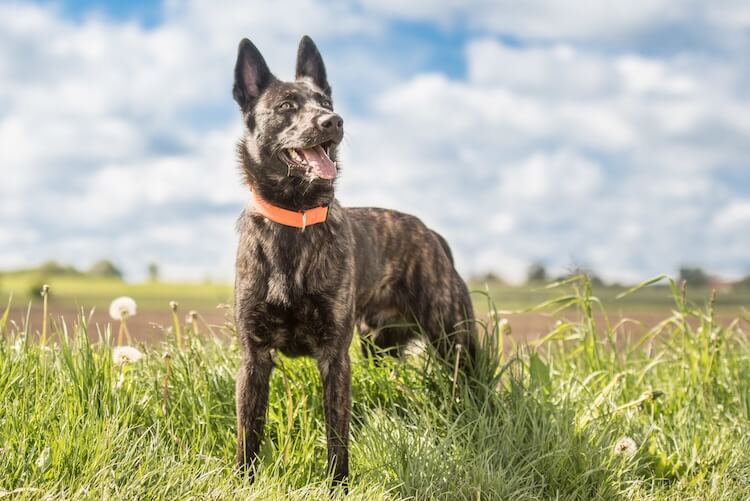
Food and Diet Requirements
| Daily Food Consumption | |
|---|---|
| Guide | 1,200 calories |
| Cups of Kibble | |
The Blue German Shepherd is very resilient and will do well on all three of the following diet types:
- Raw
- Dry
- Wet
Whatever you feed, they will need around 1,200 calories a day, with 18-24% protein and 7-10% fat. Stick to one high quality feed and use it consistently with the same meal times.
Stick to one type of food and diet, dietary changes can upset your dog’s stomach; especially as puppies.
Protein is very important for the muscle condition of your blue German shepherd and fats are essential for keeping your their coat soft.
A good example of a healthy and yet nutritious raw meal for your dog is raw fish. The meat is lean and protein rich, and the Omega-3 will be very beneficial for their coat.
Exercising Your Dog
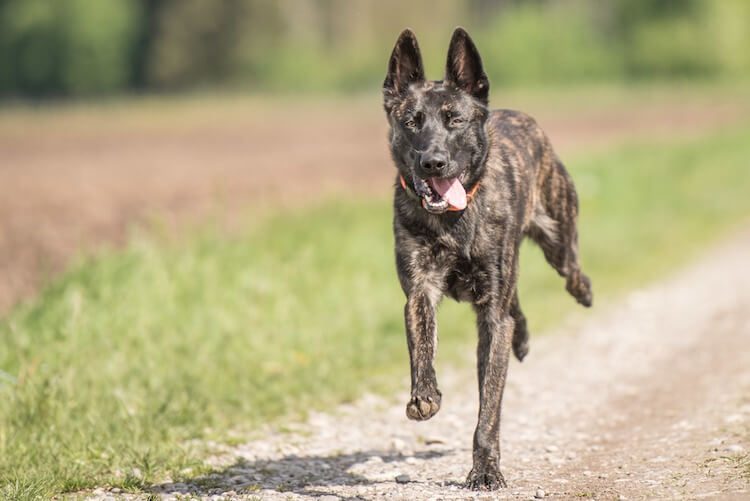
| Daily Exercise Requirements | |
|---|---|
| Minutes | 120 minutes |
| Activity Level | |
The Blue German Shepherd is no different than a traditional tan Shepherd (apart from their color), so due to the fact they were bred to work, German Shepherd Dogs require a lot of exercise.
When full grown, like most shepherds, these active dogs need around 120 minutes of exercise a day.
Whilst growing, they need much less exercise, around 5 minutes for every month of their life (for example, a 9-month-old German Shepherd Puppy should be walked for around 45 minutes a day).
Ideally, these walks should be spread throughout the day, as GSD do not do well with being cooped up.
Access to a penned in outdoor area, or a garden, may help with their exercise needs too, as it will allow the dog to self-exercise, but, this is not a suitable replacement for a good walk.
You may also wish to try taking your dog swimming, running or hiking with you.
Dogs that do not get enough exercise may become destructive due to frustration.
If on occasion you are going to be away for long periods of time, try using things at home to keep them entertained, such as a Kong.
German shepherds not only require lots of physical stimulation, but lots of mental stimulation, too.
Try playing games such as hide and seek, hiding toys, food or even yourself to entertain them. Games such as hide and seek can also be useful for encouraging your dog to hone in their natural skills, using their ears and nose to locate their prize instead of their eyes.
Training Advice
The blue German shepherd is a very intelligent dog and German shepherd training can be easy.
They were bred to work so they have a natural drive to learn, and so with lots of encouragement training should be a breeze.
As previously mentioned, German shepherd dogs are very loyal dogs and so tend to suffer from separation anxiety. This can be treated from a very young age and should be addressed almost as soon as you get your new puppy home:
- Try leaving your puppy alone for very short periods of time (no longer than thirty seconds) with lots of praise and reinforcement on return
- Over the next few weeks try to work this up to more extended periods of time until they can be left unattended for longer timeframes
A lot of training guides will advise you to use a dominance-based training approach with a German shepherd dog.
However, this technique is dated and actually will have negative effects on your dog. These methods rely on intimidation and fear which can be very stressful for your dog and can even create a negative association with the owner.
Health Problems
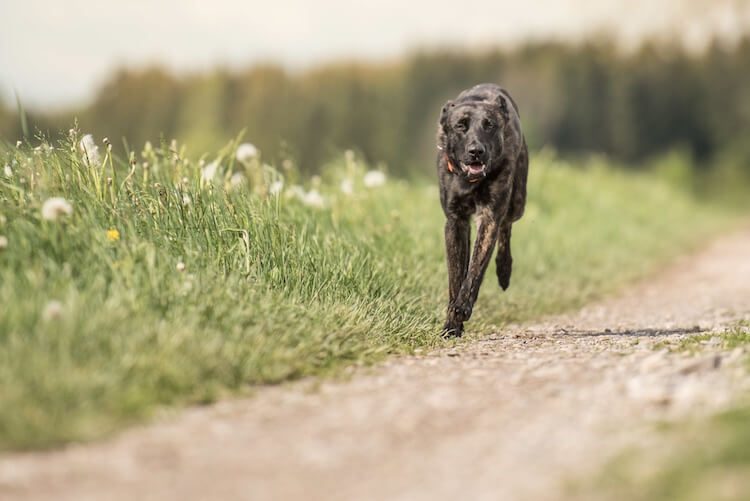
The biggest health concern for a blue German shepherd is hip dysplasia.
This is the abnormal formation in the hip joint, causing a slow breakdown of the cartilage and pain when moving. This can be treated with anti-inflammatory medication but in more extreme cases this will require surgery to correct.
The selective breeding and inbreeding of German shepherds from a single bloodline, has caused genetic issues and mutations associated with inbreeding:
- Degenerative Myelopathy, is a slow, non-painful degradation of the spinal cord, and is ultimately fatal.
- German shepherd dogs are also at risk of developing Congenital Heart Defects:
- Aortic Stenosis
- Pulmonic Stenosis
- Patent Ductus Arteriosus
Some other minor health concerns with the German Shepherd include:
- Panosteitis (known as “growing pains”), this a short lived condition that is noted for its limping usually occurring in dogs aged 5 to 18 months. This condition can be treated with medication but usually resolves itself once the dog is full grown.
- Pannus is an autoimmune disease condition affecting the eye. Although the condition cannot be cured, catching and treating Pannus early allows for the disease to be managed.
- Hemophilia which is a genetic condition making the blood to be unable to clot. Understandably, this can be very dangerous if not diagnosed early.
Health Insurance
Due to their propensity for developing serious health conditions, it may be a good idea to consider pet insurance for your blue German shepherd.
On average, it costs $20 USD per month, or around $240 USD per year to insure this dog.
Blue German Shepherd Appearance, Coat, and Grooming

As described by their breed standard, they have strong, muscular bodies, with a chiseled head, intelligent eyes, and upright, triangular ears.
Although this article focuses on the blue German shepherd, it is important to note that this dog can be seen in many different colors, including:
- black and tan German shepherds
- gray German shepherds
- liver German shepherds
- sable German shepherds
- white German shepherds
- black German shepherds
Grooming
There are two types of German shepherd coats:
- Long haired German shepherd
- Short haired
Long haired Shepherds have a double coat, meaning they have a soft, thin undercoat, and a thicker, wavy overcoat.
As a result of their double coat, German shepherd dog’s shouldn’t be clipped as this will interfere with their heat regulation.
It is important to recognize that these dogs do not need regular bathing.
Frequent bathing strips the oil from the coat and removes shine as well as drying out the skin. Bathing every three to four months will be plenty for the German shepherd.
Despite this, they will need a lot of grooming, especially the longer haired German shepherd.
Short haired German shepherd dogs tend to shed more as they do not have the undercoat, so their hair falls straight out. Use a de-shedding brush and a rake to brush through the undercoat.
Nails should be clipped when necessary by a professional, such as a groomer or veterinarian.

Summary
The blue German shepherd is a very popular puppy, and it is not hard to see why.
Quick as a whip, and highly adaptable, these dogs make excellent companions for people from all walks of life.
With a high energy drive and grooming requirements this dog will require an active and consistent owner who can dedicate time to this dog.
What do you make of the beautiful blue German shepherd dog?
Leave us a comment giving us your thoughts on this breed below.




Love my GSD he is 1 year old and weighs 110 pounds he is very loyal and a lot of fun to play with. We exercise him twice a day with a run with the golf cart he has good stamina an endurance he can now out run the golf cart.
They look brindle color in the pictures similar to the Dutch Shepherd. I have a 1/2 Dutch 1/2 German he is brindle the best one I have had out of many
I have a 3 year old female gsd with the recessive gene and I just found a male right up the road from me. Can’t wait to get them together and give us some blue pups.
Who ever wrote this article should actually learn the topic before writing a story. Lots of photos of (brindle) Dutch Shepherds used instead of a proper blue shepherd.
The blue Colouring comes from a Recessive gene somewhat akin to albino which creates a faded out version of a Normal shepherd’s colouring.
All of the dogs pictured above, “Blue German Shepherd Appearance, Coat and Grooming” are either dutch shepherds, dutch shepherd crosses, or gsd and malinois crosses. Without DNA testing there’s no way to know which of the potential 3 they could be. But one thing is absolute, they are not “blue shepherds.” I think it really benefit your reputation and improve the impact of your blog if you presented accurate information.
I’msure you mean well, but its reallybad business to post incorrect information on any topic.
What DNA test would you recommend? From where I geuss. I would like to get some background on my 5 GSD’s. Info on their Gene’s. TIA